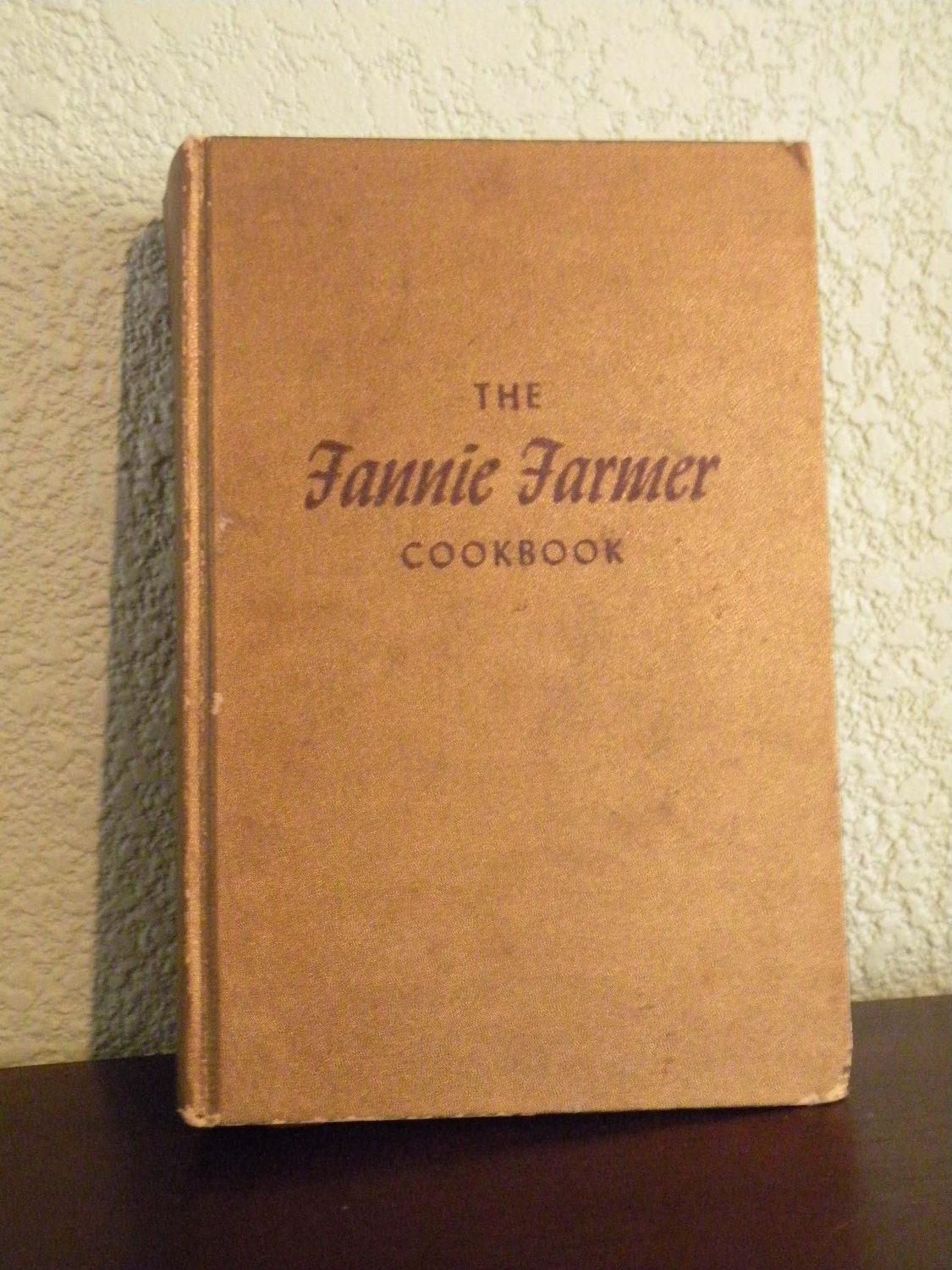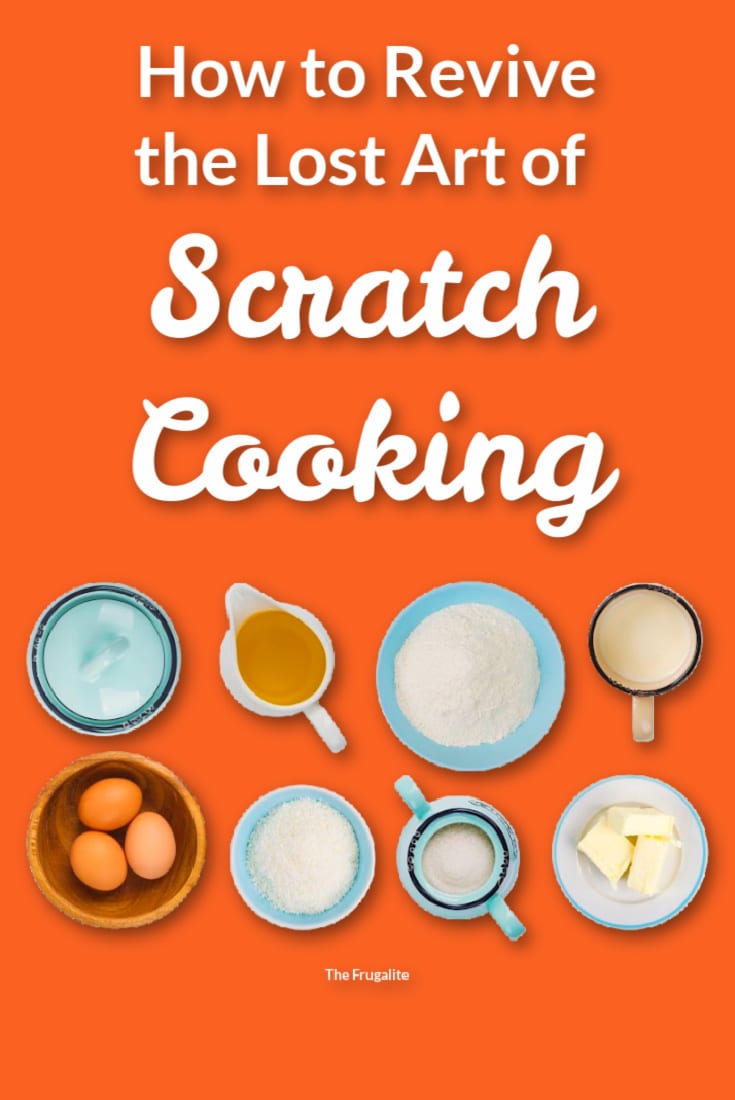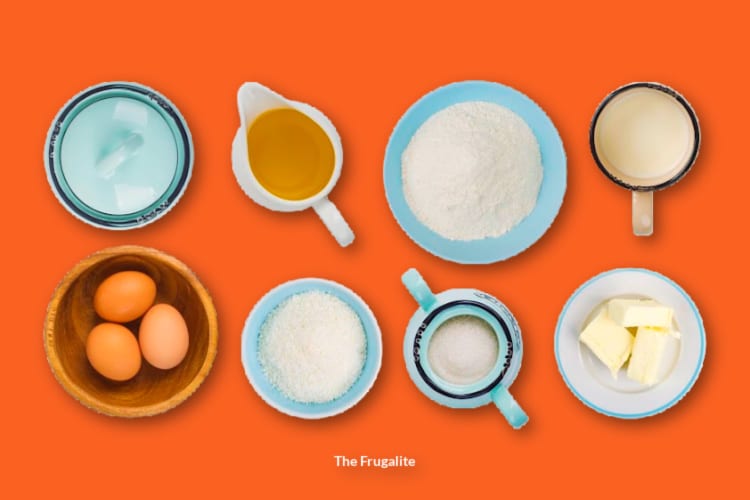(Psst: The FTC wants me to remind you that this website contains affiliate links. That means if you make a purchase from a link you click on, I might receive a small commission. This does not increase the price you’ll pay for that item nor does it decrease the awesomeness of the item. ~ Daisy)
If you compare the meals served in many of the kitchens today to meals served 100+ years ago, there is one very big difference. Nearly every meal served in North America has at least one dish that has come from a box, bag, or pouch.
Take breakfast, for example. Did you have toast? If so, did you make the bread? Cereal? One of those little packs of Quaker oatmeal, all flavored up and just waiting for you to add water? Did your breakfast originate in the freezer? Frozen toaster versions of pancakes, waffles, and pastries abound in many kitchens.
Many years ago, I did a “Scratch Challenge” on my other website, during which everything we ate had to be made from scratch – no convenience ingredients allowed. It wasn’t until I did this that I realized that even in my fairly “clean” kitchen, there still remained a lot of processed items.
You might be surprised how much processed food you actually eat.
If you do a quick survey of your own kitchen, you may be surprised at what you find. I discovered that the best way to clean up my act was to focus on cooking only from scratch. Now, my kitchen has only a few holdouts, most of which are there for food storage purposes.
Some of the most common processed items that “sneak in” are dairy and grain products:
- Bread
- Yogurt
- Cottage Cheese
- Crackers
- Pitas
- Tortillas
- Cereal
- Pasta
None of these would be incredibly difficult to make, but they ARE time-consuming. In a world that is ever-increasingly geared towards convenience, few people take the time to roll out noodles or bake cookies these days. Birthday cakes come from the bakery, cookies come from a bag with a convenient tab to reseal it, and bread comes from a shelf at the grocery store, so perfectly uniform that if you put it back and mixed all the loaves up, you’d never find the original loaf. (Anyone who has ever baked a loaf of bread will tell you, they all get a funny lump here and there!)
All of this easy-access food has taken a deeper toll than you might imagine.
…A toll on our health.
…A toll on our waistlines.
…A toll on our ability to make the simplest item on our own.
…A toll on the time we spend with our families.
…A toll on the next generation, when we fail to teach them the arts that are vanishing as our grandparents pass away.
Cooking from scratch is actually an analogy for today’s society. Those who take the road less traveled are considered eccentric throw-backs to a faraway time.
People feel that we are making unnecessary work for ourselves and that our lives would be vastly improved by tossing a shiny cellophane bag of bread into the grocery cart instead of taking a couple of hours to mix the ingredients, knead the dough, let it rise, knead it some more, then shape it into the desired form.
But when you toss that bag of bread into the cart, you are getting undesirable ingredients. You are missing out on teaching your child how to judge the composition of the dough by the feel of it in her hands when she kneads it. You don’t get to inhale that delicious aroma emanating from your oven, and you totally skip that mouth-watering anticipation as you let the loaf rest long enough for you to slice it. Packaged bread from the store doesn’t serve as so fine a vehicle for melting fresh butter and transferring it to your mouth once you finally get to cut into your fresh, wholesome bread.
Scratch cooking is easier than it seems.
The media is partly to blame for making it seem difficult to actually cook. Most of the advertisements for processed food available at the grocery store tout the convenience of these items. You never see a mom with flour all over the front of her apron and her hair in a ponytail. Instead, the TV-commercial mothers are perfectly coiffed, wearing high heels and a skirt, placing a dish on the table with a flawlessly manicured hand. They are never rushed or harried, of course, because they’ve used pre-shredded cheese along with their premade noodles and their can of sauce. They look like they just stepped out of the office and “poof” a dinner has appeared in their kitchens.
If you can read and possess the ability to use a measuring cup, you can cook. It’s that simple.
It seems almost fashionable lately to claim an inability to cook, as though preparing food is beneath a certain level of sophistication. When you start out, sure, there is some trial and error. Sometimes you end up having a peanut butter sandwich in the early years. But for the most part, with some very basic tools, cooking is foolproof.
Case in point: my oldest daughter was a little bit behind on reading when she was in 3rd grade. However, she had a fascination with cooking. So, to help improve her reading skills, I began letting her cook. She would pour through my cookbooks and choose a meal. She’d make a list, then we’d check what we had in the house and what we needed from the store. When she was 9 years old, she made a cheese lasagna, from scratch, including the marinara sauce, completely unaided. (And it was delicious!)
Basic scratch cooking is not some mysterious art that requires 4 years at Le Cordon Bleu in Paris – it’s just a simple matter of reading instructions and putting them into action.
It doesn’t take that much additional time.
The thing is, with a bit of pre-planning, even the busiest working mother can cook from scratch, without the use of convenience items.
Every weekend I spend a few hours in the kitchen prepping food for the week ahead. I do some baking (cookies, granola bars, and bread), clean and chop up veggies, pack little containers of healthy snacks for my daughter’s lunch, and cook a few items to be used throughout the week. I usually roast something on the weekend and cook up some seasoned ground beef or turkey, then add these things to meals throughout the week. I was more focused on this when I worked outside the home, but still do it to some degree.
Never forget about your crockpot! That valuable kitchen appliance can have dinner ready and waiting when you get home from a long day at the office, in the garden, or out with the kiddos. It makes delicious pot roasts and even rotisserie-style chicken! It’s also great for soups, stews, chili, and spaghetti sauce. You can make the cheapest cut of meat tender and delicious by slow-cooking it for 10 hours on low, so this is helpful to the budget as well. (Check out more time-saving suggestions HERE.)
It’s healthier.
Any item you make from scratch is going to be far healthier than its convenience food equivalent. Take cookies, for example. Who doesn’t love cookies? When my kids were at home, I baked them 2-3 times per week – there were always some in the jar. But they contained wholesome ingredients like freshly ground flour, organic sugar, coconut oil, and dried fruit. The ones that I would buy at the grocery store, 9 times out of ten, would contain unsavory items like HFCS, GMOs, additives, and preservatives.
The sad thing is, if you look at the labels on the convenience items at the store, they like to tout the health benefits all over the brightly colored package. It makes me livid that people are being fooled by this. Stamps of approval from the FDA, the American Heart Association, the USDA, and other nutritional agencies mean absolutely nothing except that the manufacturer of the product has made all the right donations. If a food has to be “fortified” with vitamins and minerals, that essentially means that the basic food has been depleted of those beneficial nutrients and that they had to be added back in artificially. Your body is miraculously designed to take nutrients from food and it doesn’t recognize many of these artificial versions of nutrients as such.
When you make it yourself, you know precisely what is in it. You know that your family member with allergies is safe and that you aren’t unknowingly consuming ingredients that do double duty as drain cleaner.
It’s cheaper.
You will save a TON of money cooking it yourself. For example, a one cup serving of brown rice, cooked in broth and prepared from scratch costs less than 10 cents (and contains nothing yucky). A one cup serving of flavored Uncle You-Know-Who’s rice costs up to $1. A cup of oatmeal from bulk-purchased steel cut oats costs about 5 cents, but a little brown packet that you pour boiling water over costs 50 cents.
The reason for this? Time is money. Whether it’s your time or the food manufacturer’s time, there is a cost involved. Some people feel that it’s worth it to pay for this convenience. What they don’t consider is that the hands-on time in cooking these items from scratch is often minimal. I use the oven to bake my brown rice and all I have to do is bring the pot to a boil on the stove top, put it in the oven for 1 hour, and walk away. If that hour is not “hands-on time” then I really don’t think that it could be considered an hour of actual work, do you?
Shopping to stock your pantry and purchasing basic items in bulk will save you a fortune at the grocery store. As an added bonus, you’ll find that by keeping a good supply of all of your basic items, you will end up having to make fewer trips to the grocery store. (And come on, every time you go to the store, if you’re anything like me, you end up with at least ONE thing that wasn’t on your list! See? More savings!)
Here’s how to get started with scratch cooking.

With the internet, you can find basic instructions for making just about anything. Find an author that doesn’t use hard-to-find ingredients and that shows step by step illustrations. I really love the Martha Stewart website for the clarity of the instructions, but Martha is in a rather different economic bracket and sometimes her recipes contain very pricey ingredients. Her 101 articles can’t be beaten, though!
Next, be sure you have some basic kitchen supplies. You need basic cookware and utensils, obviously. Other useful (but not 100% necessary) items are:
- a kitchen timer (this is very very important unless your attention span is far more keen than mine)
- an inexpensive little food processor
- an instant-read thermometer (more important when you’re just starting out – later you will be able to judge when something is the “right” temperature)
- a good sharp knife
- a box grater with different sized holes
- a set of measuring cups and spoons
- a colander
- a whisk
- a potato masher
- a crock pot
I’m not a huge fan of gadgets, particularly electric ones. They take up lots of space, you become reliant on them, and they’re expensive.
There are also some basic scratch-cooking ingredients you’ll want to have on hand at all times in addition to your regular groceries.
Experiment!
Once you have the basics down, you can begin to experiment, and this is what separates the “decent” cooks from the really “great” cooks. Initially, don’t veer too far from the original recipe. You can start by altering the spices to suit the preferences of your family. Next thing you know, you’ll look at a recipe, get a general idea of what they’re making, and then set off to create your own unique dish!
Recommended Reading:
- The Fannie Farmer Cookbook
- A Cabin Full of Food
- Never Buy Bread Again (absolutely the best bread-making book on the planet)
- Better from Scratch
- The Elliott Homestead Cookbook
What about you?
What are some things you make from scratch that you used to buy? How did you learn to cook? Let’s talk about it in the comments section.












11 thoughts on “How to Revive the Lost Art of Scratch Cooking”
I continued to cook from scratch! Just made a batch of GF brownies, a GF apple strudel and for dinner tonight: fish chowder with garlic bread (on my homemade bread).
I’m an art teacher and business owner. Married and my two adult children live at home. I grow my own veggies year round and I’m a proud doggie mom to 4 beautiful pups. I maintain my health through natural supplements and daily exercise like kickboxing.
So yes, if I can cook from scratch every night, anyone can!
For me I mainly cook from scratch because it’s so much cheaper & my kids are healthier and eating from scratch effects their behaviour. Less preservatives & colours = happier kids = same mum. I try to grow as much as I can too nothing beats the taste of fresh from the garden and cheap if you use seeds. I find if we grow it, they eat it. My shopping rule is green grocery store first & then the supermarket. The green grocery loves us, we spend quite a lot there. And he often offers us on the spot specials as we are such good customers . The first thing I do when we get home is wash , chop and blanch & freeze. It makes sure there is little food waste . No point buying all that fresh food if you end up throwing it out. I plan my meals to reduce my cooking time. And if I can I try put a couple full meals in the freezer if we are having a tough day. Stops buying take away we can’t afford & the kids don’t eat anyway. They just like the idea of it . I am lucky enough to have a few old cook books. The internet often fills the gaps. Loads of great , cook from scratch recipes if you look. A few years ago I did a cooking class with kids in low income area. Start with the kids and see the results. We helped put in a garden at the school to grow and cook lunch foods what a difference in health, weight, behaviour & the kids became little teachers . Was heart warming !
Izzy, that’s awesome! My parents didn’t bother to make meals and we hardly saw a vegetable at all. When I got older I discovered all kinds of delicious healthy food I’d been missing. You’re really doing a service for those children by showing them they can be in control of what they eat and that natural foods taste fantastic. God bless.
Thanks Aunt Mary, I can totally relate, my mum cooked mostly processed foods , she did bake occasionally. It wasn’t homely meals, it was just to fill out tummys but my amazing nan taught me what meals should be , healthy and bringing the family together.
The cool thing I found about cooking from scratch is that the base ingredients can be combined so many different ways. For example, when you have the basic ingredients for baking at home, you can turn out cinnamon rolls, breads, cookies, muffins and pot pies with the ingredients. If you’re out of one ingredient, the others can usually be combined to make something else. If an extra guest shows up, you can add another ingredient to what you’re cooking to stretch it.
When you cook from boxes and bags and you’re out of something, you’re just out of that category of food until you go to the store again. Not that there’s anything wrong with PBJ and milk for dinner, but it’s nice to have the flexible options.
I collect older cookbooks as gifts for friends and young people. I was horrified at the many people having surgeries to loose weight. I have a Fanny Farner, a French cookbook that teaches a myriad of basic things, and a few others I keep handy. I grew up with parents who loved to garden and preserve foods. Everything was home made. I learned a lot from them. I love non electric kitchen gadgets. I buy whole grains to cook or grind. I raise chickens, ducks, and rabbits and always grow a lot of our foods. I can and dry a lot for the future. I’m rebuilding a solar oven and another solar dehydrator. My rolled oats and rolled rye are slow cooked as breakfast cereals or added to bread dough. I have sourdough starter and commercial yeast. Whole wheat berries appear as cereal, in breads, and cooked then chilled in tabuli salad.
Grandma used a hay box to cook while she helped work on their rural apple farm. They raised pretty much everything they ate. Grandma built a springhouse and grandpa did most of the butchering. They built a smokehouse , salted down meats and made charcoal together. Much of that knowledge was passed on to children and grandchildren. Grandma and Mom both owned pressure cooker canners and waterbath canbers. So do I. infact I now use mine and Moms that’s almost as old as I am. She bought hers about 1950. I bought a new pressure canner in 2012. I use both of them. My 3 waterbath canners date to 1920, 1946, and 1963. I have purchased new rack for one of then. I still use a 1951 sieve that I grew up with. We love good food and scratch cooking. And yes sometimes I use some processed things when time is short.
My mother made all things from scratch, even noodles and white sauces. She was a plain cook, nothing fancy, but her table was always set with lovely dishes containing really good food. We enjoyed homemade bread made without a bread maker, beans in a cast iron pot that took 2 days to make, home made jellies and jams, and you name it, she could cook it.
I remember seeing her really angry once after she had served a completely wonderful chocolate cake with her homemade fudge frosting. One of her guests (a man married to Mom’s cousin) remarked that he only allowed cake mixes in his home because then there was uniformity meaning no ruined food. Being more polite than her guest, Mom waited until he had left to throw a small tantrum.
My mom lived to be 96 while that man, insisting that all foods be processed for the sake of uniformity died in his 50’s.
I have many of her recipes including chicken on biscuits which I serve to crowds, and her beef vegetable soup which is a first day of snow favorite. My kids grew up on home made mac and cheese, chili, and vegetables cooked with flavor. I did not serve fancy, but like my mother, meals were balanced and flavorful. We did not take them to fast food for dinner nor did we use boxed crutches, as Mom called prepackaged foods. I am appalled at the eating habits of Americans, especially not sitting down as a family and eating a decent meal.
An interesting aside: I found at lunchtime in the summer that I had at least 6 or 7 kids dropping by. Of course they stayed to eat, gleefully gobbling loose meats, sandwiches, vegies, fresh fruit, milk, and cookies. I asked them once why they didn’t eat at home, and the reply was that I was the only mom who cooked for them. I took it as a compliment but felt bad about the lack of nutrition in those homes.
I worked full time as a teacher, but I found time to make a home. I’m so proud of my children, now adults with their own families and jobs. The tradition of sitting down to home cooked meals with a properly set table is being carried on. My mother knew that family harmony began with the dinner table.
I love scratch cooking. Sometimes I’ll use a canned soup or a stew, usually as an ingredient for something else, but usually it’s about 90% scratch. Like I’ll get canned tomato sauce and add my own spices when I’m making pizza, that kind of thing. Bread and all kinds of other stuff are pretty much from scratch. I can’t remember the last time I used a frozen dinner or something like that.
There’s one common kitchen item I’d add to that list though! Maybe it’s under “basic kitchen tools” but I’d add a sturdy wooden spoon. It’s useful for so many things and makes putting together batters so much easier. I’d put it at about the same usefulness level as a whisk but not as useful as a sharp knife.
Oh – I have to add just one more thing. Yesterday when I was off buying veggies to pickle, I got to talking with the young cashier and she revealed the she didn’t know how to cook green beans. So I told her – quickly and simply – how to do it, and a couple ways of seasoning them. Blew my mind just a little.
One issue not discussed above is the possible contamination of foods you buy that you hope are not contaminated, OR if they likely are to some degree … learn how to compensate in either your shopping choices or your cooking process to minimize bad effects on your health. One example is rice. I happen to like brown rice a lot but in the US the majority of rice grown here comes from former cotton fields in Southern states. Many of those fields today have considerable arsenic … which gets passed along to harvested rice. California is a useful exception. Also there is less of a problem with Asia sourcing. I’ve learned to buy Basmati rice from India, Pakistan or Nepal. Fortunately my local India Bazaar store has an enormous supply of such rice — vastly larger than what the local Walmart carries where most rice is NOT labeled with the location origin. The Lundberg family farm- grown rice from California is a notable and safe exception.
There are several useful videos on YouTube about the rice sourcing problem (and kitchen fixes to some extent). Simply search on RICE ARSENIC to pull up a variety of relevant videos there.
The point is that with some ingredients for cooking from scratch there can be a need for a significant learning process as well as extra kitchen time … to compensate sometimes for dangers your local grocer will not warn you about.
–Lewis
I remember asking my mom, “Can you make brownies without a box mix?” I had never seen her do it!
I probably got started cooking from scratch by looking at the taco flavoring package. I have all but the chemicals at home already!
Why buy speghetti sauce? Chop up vegies and saute a bit, add tomato sauce (I have not canned tomatoes yet!) and garlic, and spinach for “Christmas” speghetti!
Every little step moves you closer to health and gives you confidence that you can make nutritious, tasty food for far less than the commercial boxes and cans or eating out. Little steps add up to good health and a balanced budget.